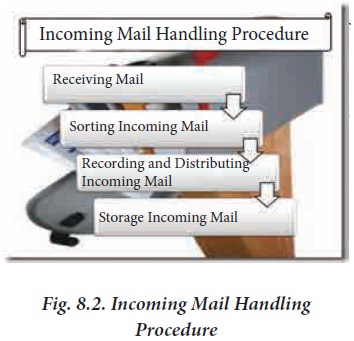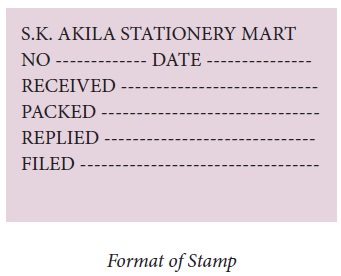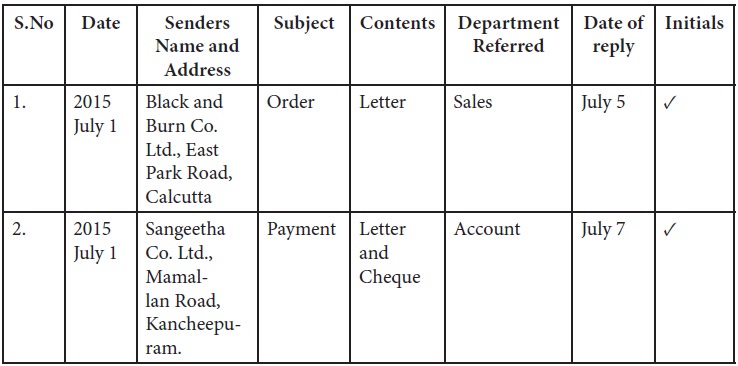Chapter: 11th Office Management and Secretaryship : Chapter 8 : Secretarial Correspondence
Procedure for Handling Inward Mail and Outward Mail
Procedure
for Handling Inward Mail and Outward Mail:
Meaning of Mail:
The
term “Mail” in the common parlance refers to written communication.
It
may be either received or sent out. A mail received is known as inward mail and
a communication sent out is called as outward mail. As stated already, every
business organization receives as well as sends a large number of mail every
day.
Definitions:
George R. Terry rightly remarked that “it is doubtful that a modern office could exist without
mail”. The reason is obvious that every business house has to maintain close
contact with the outside world. It should correspond to its customers, its own
branches, departments, and various other institutions, government etc., the
business firm grows; the volume of transactions will also grow.
Procedure for Mail Handling:

1. Receiving the Mail:
Generally mails are received once or twice a day as delivered by the postman, when the
volume of correspondence is large, a post box or post bag is hired in the post
office, and an office peon is sent to collect the mail from the post office.
Sometimes letters are received through the messengers of the offices. In the emerging
scenario private courier services rendering very speed post service to the
office.
2. Sorting the Mail: After the mail has been received in the mailing department, it should be sorted out before
it is opened. It is easier to sort out sealed envelopes than different sized
pieces of paper. Private letters of the employees may be sorted out at first
than comparing to the business letters.
Business
Letters should be sorted out into three groups:
a.
Registered
and unregistered letters or mail;
b.
Sealed
and unsealed envelopes; and
c.
Confidential
and urgent letters, private or personal, secret, and other official letters.
Sorting
of letters means grouping of letters on definite order. Sorted mail makes the
delivery of letters convenient and quick.
3. Opening the Mail: Letters may be opened by hand or by letter opening machines. A paper knife is
mostly used in offices to split open envelopes etc. If the number of letters is
very large, a letter opening machine may be used with advantage. In small
organisation letters are opened by the officer or head clerk. The following
guidelines may be followed for opening the mail.
a.
The sorting and Opening of the mail should start atleast half an hour to one
hour before the opening time of the office.
b.
The office manager should see to it that the work in the office start
immediately after the opening of the mail, otherwise the time and money spent
on an early opening of the mail would be wasted.
c.
The staff is incharge for opening the mail should be fully conversant with the
method of sorting and opening the mail. If possible, a mailing manual should be
used in this regard.
d.
After an envelope has been opened, it is necessary to remove the content from
it. Empty envelopes should be fastened by a pin or clip or stapler.
4. Scrutiny of
Contents: After
the removal of the contents, it must
be scrutinised to find out for whom and for which department, they are meant
for. The sorting of letters has been done on a departmental basis at this
stage. Before sending the mail to the concerned departments, the enclosures to
the letters should be checked, compared and verified with the covering letter
to find out whether they are in order or not. Occasionally, the enclosures may
be a cheque, bank drafts, postal order or a valuable document. If any
discrepancy or omission is found while scrutinising then the matter should be
immediately brought to the notice of the mailroom supervisor. Letters in which
certain previous references are given may be sent to the filing department from
where the letters and the relevant files may be sent to the concerned
department.
5. Stamping the Mail: After proper scrutiny is done, the date stamping of letter must be done.
Sometimes the date and time of receipt would be stamped on the letter. For
stamping of letters, a stamp is prepared which contains the serial number, the
date of receipt and time of receipt if necessary. A references stamp is
attached if the letters relate to numbers of departments. A design of specially
design stamp is given below.

6. Recording the Mail:
After the stamping work, letters received are recorded in inward mail
register or letters received book. Before recording of letters in the register,
the contents are scrutinized properly so as to ensure the department to which
it belongs. The inward mail register contains 1. Serial number 2. Date of
receipt 3. Senders name and address 4. Nature of contents 5. Subject of
the letter in brief 6. Remarks and initials of the officer with date.
A specimen of an Inward mail Register is given below:
Inward Mail Register

7. Distributing the
Mail: This
is the last step in the inward mailing
routine. In this stage letters are handed over to the concerned departments.
The letters are distributed through messengers or sometimes with the help of
mechanical devices like conveyor-belt or pneumatic tube.
8. Follow up Action: Follow up action is very important because it is concerned with keeping track of mail.
This stage makes an enquiry whether the letter is replied or not.
Related Topics